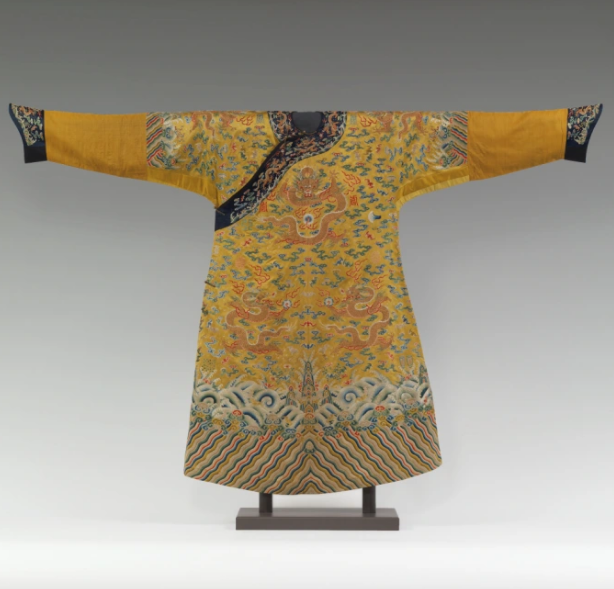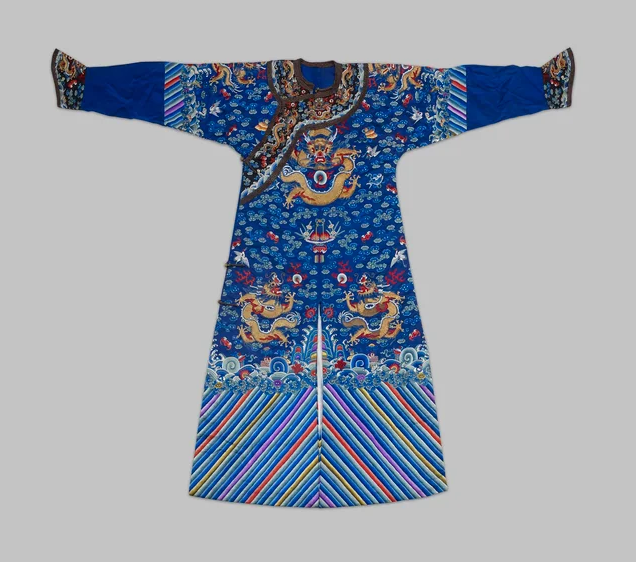Historical Origins of Dragon Robes
Early History and Evolution
Tracing the roots of dragon robes, their story begins in ancient China. Skilled artisans crafted these garments, intertwining silk threads with utmost precision. Initially, these robes served as symbols of power and authority, exclusively adorned by emperors and high-ranking officials. Over time, their design evolved, reflecting changing dynastic styles and imperial decrees. Each robe, a masterpiece, bore the mark of its era, from the Shang dynasty’s rudimentary patterns to the Qing dynasty’s intricate designs.

Cultural Significance in Imperial China
In Imperial China, dragon robes were more than mere clothing; they were embodiments of divine power and imperial dignity. The dragon, revered as the emperor’s symbol, dominated these garments’ designs, signifying the ruler’s celestial mandate. Wearing such robes, emperors conducted rituals and state affairs, projecting their authority and divine lineage. These garments also played a critical role in diplomatic ceremonies, with envoys and foreign dignitaries often receiving them as gifts, symbolizing respect and the empire’s magnanimity.
Throughout this narrative, dragon robes serve as a vivid tapestry, weaving together stories of power, artistry, and tradition. They reflect a rich cultural heritage, a testament to the skill and creativity of ancient Chinese artisans.
Materials and Fabrication Techniques
Silk Weaving and Dyeing Processes
Silk, the primary material for dragon robes, undergoes a meticulous weaving process. Artisans carefully raise silkworms, ensuring a diet of fresh mulberry leaves for the finest silk. They then spin this silk into threads, a process requiring precision and patience. Dyeing these threads involves natural dyes, often derived from plants, minerals, and insects. This technique ensures vibrant, lasting colors. The weavers integrate these colored threads into complex patterns, a task demanding both skill and an eye for detail.
Embroidery and Ornamentation Methods
The art of embroidery takes center stage in dragon robe ornamentation. Artisans use a variety of stitches, each chosen for its texture and visual impact. They often incorporate gold and silver threads, adding a luxurious sheen to the robes. These threads are not only aesthetically pleasing but also symbolize wealth and power. Ornamentation often includes pearls and semi-precious stones, meticulously sewn onto the fabric. This embellishment process is time-consuming, reflecting the garment’s prestige and the wearer’s status.
In these techniques, we see a blend of art and function. Each step, from spinning silk to adding the final embellishments, reflects centuries of refinement. These methods showcase the artisans’ dedication to preserving their cultural heritage, ensuring that each dragon robe is not only a garment but a piece of history.
Symbolism and Design Elements
The Significance of Dragons in Chinese Mythology
In Chinese mythology, the dragon stands as a symbol of supreme power, wisdom, and prosperity. Dragon robes prominently feature this majestic creature, often depicted amidst clouds, waves, or mountains, representing its command over natural elements. Emperors wore these robes as a sign of their divine right to rule and their connection to the celestial dragon. The dragon’s depiction varies, with the number of claws and its position indicating the wearer’s rank and power.
Color and Pattern Variations in Robes
Dragon robes showcase a rich palette of colors, each with its own significance. Yellow, reserved for the emperor, symbolizes the center of the universe and imperial power. Other colors like blue, red, and green indicate different ranks and statuses within the court. The patterns on these robes are not random; they follow strict guidelines, with specific motifs like the phoenix, lotus, and ocean waves. These elements not only add to the aesthetic appeal but also convey messages about the wearer’s virtues, responsibilities, and position in the cosmic order.
The meticulous design of dragon robes, combining symbolism with artistic expression, reveals the profound cultural and spiritual beliefs of ancient China. Every stitch and color choice carries a deeper meaning, connecting the wearer to a long-standing tradition and a complex system of beliefs and values.
Artisans and Workshops
Training and Skills of Robe Makers
Robe makers in ancient China underwent extensive training, mastering various techniques over years. Apprentices started young, learning from master craftsmen. They honed skills in silk weaving, dyeing, embroidery, and tailoring, each requiring precision and artistic sensibility. Mastery in these skills was not just a matter of technical proficiency but also a deep understanding of cultural and symbolic significance, which they meticulously incorporated into each robe.
Famous Workshops and Their Contributions
Several renowned workshops emerged, each known for their unique contributions to robe making. The Imperial Workshop, directly managed by the court, was famous for its exquisite craftsmanship and use of the finest materials. Other notable workshops like the Suzhou and Hangzhou studios were renowned for their innovative designs and techniques in silk weaving and embroidery. These workshops not only supplied robes to the imperial family but also influenced the broader textile industry in China, setting standards in quality and aesthetics.
The legacy of these artisans and their workshops is evident in the extraordinary quality and beauty of the dragon robes they produced. Their dedication and skill not only served the needs of the imperial court but also enriched Chinese cultural heritage, leaving a lasting impact that transcends time.
Imperial Usage and Regulations
Dress Codes in the Imperial Court
In the Imperial Court, dress codes were stringent, reflecting social hierarchy and order. The emperor exclusively wore dragon robes with five-clawed dragons, a privilege no other could claim. High-ranking officials and nobles had robes with fewer claws on their dragons, indicating their rank. Even the colors and patterns were regulated, with specific hues designated for different ranks and occasions. These dress codes reinforced the rigid social structure of the court and the emperor’s supreme status.

Ceremonial and Daily Wear of the Dragon Robes
Dragon robes served various purposes, from daily wear to special ceremonies. For daily affairs, emperors and officials wore simpler robes, still elaborately designed but less ornate than ceremonial ones. During important events like coronations, New Year celebrations, and religious ceremonies, they donned their most elaborate dragon robes. These robes, rich in symbolism and intricacy, were not merely garments but a display of power, tradition, and divine right.
The rules governing the use of dragon robes in the Imperial Court were not just about fashion but were deeply entwined with the cultural and political fabric of Imperial China. They were a visual representation of the empire’s values and the emperor’s role as the celestial ruler.
Preservation and Legacy
Methods of Preserving Ancient Dragon Robes
Conservation experts use meticulous methods to preserve ancient dragon robes. They employ climate-controlled environments to prevent damage from temperature and humidity. Specialists clean these robes using gentle, non-invasive techniques, ensuring the delicate fabrics and embroidery remain intact. They often use specialized storage methods, such as acid-free boxes and custom-made mannequins, to maintain the robes’ shape and structure. Regular inspections and maintenance are crucial to prevent deterioration over time.
Influence on Modern Fashion and Culture
Dragon robes have left a profound impact on modern fashion and culture. Designers often draw inspiration from their intricate patterns and rich symbolism, incorporating these elements into contemporary fashion. Museums around the world exhibit these robes, offering a glimpse into China’s rich sartorial history. The dragon robe’s influence extends beyond fashion, shaping modern interpretations of Chinese culture in art, cinema, and literature. They remain a symbol of the richness and depth of Chinese heritage.
The preservation of these ancient garments and their enduring influence highlight their significance, not just as historical artifacts but as living embodiments of a rich cultural legacy. They continue to inspire and educate, bridging the past and present.